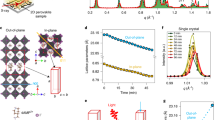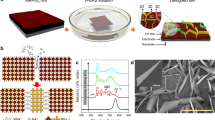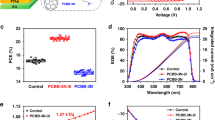Abstract
Organometal trihalide perovskites have been demonstrated as excellent light absorbers for high-efficiency photovoltaic applications. Previous approaches to increasing the solar cell efficiency have focused on optimization of the grain morphology of perovskite thin films. Here, we show that the structural order of the electron transport layers also has a significant impact on solar cell performance. We demonstrate that the power conversion efficiency of CH3NH3PbI3 planar heterojunction photovoltaic cells increases from 17.1 to 19.4% when the energy disorder in the fullerene electron transport layer is reduced by a simple solvent annealing process. The increase in efficiency is the result of the enhancement in open-circuit voltage from 1.04 to 1.13 V without sacrificing the short-circuit current and fill factor. These results shed light on the origin of open-circuit voltage in perovskite solar cells, and provide a path to further increase their efficiency.
This is a preview of subscription content, access via your institution
Access options
Subscribe to this journal
Receive 12 digital issues and online access to articles
$119.00 per year
only $9.92 per issue
Buy this article
- Purchase on Springer Link
- Instant access to full article PDF
Prices may be subject to local taxes which are calculated during checkout





Similar content being viewed by others
References
Green, M. A., Ho-Baillie, A. & Snaith, H. J. The emergence of perovskite solar cells. Nature Photon. 8, 506–514 (2014).
Snaith, H. J. Perovskites: The emergence of a new era for low-cost, high-efficiency solar cells. J. Phys. Chem. Lett. 4, 3623–3630 (2013).
Dong, Q. et al. Electron–hole diffusion lengths >175 μm in solution-grown CH3NH3PbI3 single crystals. Science 347, 967–970 (2015).
Xing, G. et al. Low-temperature solution-processed wavelength-tunable perovskites for lasing. Nature Mater. 13, 476–480 (2014).
Liu, M., Johnston, M. B. & Snaith, H. J. Efficient planar heterojunction perovskite solar cells by vapour deposition. Nature 501, 395–398 (2013).
Lee, M. M., Teuscher, J., Miyasaka, T., Murakami, T. N. & Snaith, H. J. Efficient hybrid solar cells based on meso-superstructured organometal halide perovskites. Science 338, 643–647 (2012).
Abrusci, A. et al. High-performance perovskite-polymer hybrid solar cells via electronic coupling with fullerene monolayers. Nano Lett. 13, 3124–3128 (2013).
Stranks, S. D. et al. Electron–hole diffusion lengths exceeding 1 micrometer in an organometal trihalide perovskite absorber. Science 342, 341–344 (2013).
Heo, J. H. et al. Efficient inorganic–organic hybrid heterojunction solar cells containing perovskite compound and polymeric hole conductors. Nature Photon. 7, 486–491 (2013).
Xiao, Z. et al. Solvent annealing of perovskite-induced crystal growth for photovoltaic-device efficiency enhancement. Adv. Mater. 26, 6503–6509 (2014).
Takahashi, Y., Hasegawa, H., Takahashi, Y. & Inabe, T. Hall mobility in tin iodide perovskite CH3NH3SnI3: Evidence for a doped semiconductor. J. Solid State Chem. 205, 39–43 (2013).
Wehrenfennig, C., Eperon, G. E., Johnston, M. B., Snaith, H. J. & Herz, L. M. High charge carrier mobilities and lifetimes in organolead trihalide perovskites. Adv. Mater. 26, 1584–1589 (2014).
Yin, W.-J., Shi, T. & Yan, Y. Unusual defect physics in CH3NH3PbI3 perovskite solar cell absorber. Appl. Phys. Lett. 104, 063903 (2014).
Kojima, A., Teshima, K., Shirai, Y. & Miyasaka, T. Organometal halide perovskites as visible-light sensitizers for photovoltaic cells. J. Am. Chem. Soc. 131, 6050–6051 (2009).
Jeon, N. J. et al. Compositional engineering of perovskite materials for high-performance solar cells. Nature 517, 476–480 (2015).
Green, M. A., Emery, K., Hishikawa, Y., Warta, W. & Dunlop, E. D. Solar cell efficiency tables (Version 45). Prog. Photovolt. Res. Appl. 23, 1–9 (2015).
Jeon, N. J. et al. Solvent engineering for high-performance inorganic–organic hybrid perovskite solar cells. Nature Mater. 13, 897–903 (2014).
Xu, J. et al. Perovskite–fullerene hybrid materials suppress hysteresis in planar diodes. Nature Commun. 6, 7081 (2015).
Wang, Q. et al. Large fill-factor bilayer iodine perovskite solar cells fabricated by a low-temperature solution-process. Energy Environ. Sci. 7, 2359–2365 (2014).
Heumueller, T. et al. Disorder-induced open-circuit voltage losses in organic solar cells during photoinduced burn-in. Adv. Energy Mater. 5, 1500111 (2015).
Blakesley, J. C. & Neher, D. Relationship between energetic disorder and open-circuit voltage in bulk heterojunction organic solar cells. Phys. Rev. B 84, 075210 (2011).
Liu, D. & Kelly, T. L. Perovskite solar cells with a planar heterojunction structure prepared using room-temperature solution processing techniques. Nature Photon. 8, 133–138 (2014).
Ryu, S. et al. Voltage output of efficient perovskite solar cells with high open-circuit voltage and fill factor. Energy Environ. Sci. 7, 2614–2618 (2014).
Xiao, Z. et al. Efficient, high yield perovskite photovoltaic devices grown by interdiffusion of solution-processed precursor stacking layers. Energy Environ. Sci. 7, 2619–2623 (2014).
Zhou, H. et al. Interface engineering of highly efficient perovskite solar cells. Science 345, 542–546 (2014).
Bi, C. et al. Non-wetting surface-driven high-aspect-ratio crystalline grain growth for efficient hybrid perovskite solar cells. Nature Commun. 6, 7747 (2015).
Shao, Y., Xiao, Z., Bi, C., Yuan, Y. & Huang, J. Origin and elimination of photocurrent hysteresis by fullerene passivation in CH3NH3PbI3 planar heterojunction solar cells. Nature Commun. 5, 5784 (2014).
Von Hauff, E., Dyakonov, V. & Parisi, J. Study of field effect mobility in PCBM films and P3HT: PCBM blends. Sol. Energy Mater. Sol. Cells 87, 149–156 (2005).
Xie, Y. et al. Femtosecond time-resolved fluorescence study of P3HT/PCBM blend films. J. Phys. Chem. C 114, 14590–14600 (2010).
Li, G. et al. “Solvent annealing” effect in polymer solar cells based on poly (3-hexylthiophene) and methanofullerenes. Adv. Funct. Mater. 17, 1636–1644 (2007).
Li, G. et al. High-efficiency solution processable polymer photovoltaic cells by self-organization of polymer blends. Nature Mater. 4, 864–868 (2005).
Mens, R. et al. Description of the nanostructured morphology of [6, 6]-phenyl-C61-butyric acid methyl ester (PCBM) by XRD, DSC and solid-state NMR. Magn. Reson. Chem. 49, 242–247 (2011).
Bisquert, J. Interpretation of electron diffusion coefficient in organic and inorganic semiconductors with broad distributions of states. Phys. Chem. Chem. Phys. 10, 3175–3194 (2008).
Pomerantz, Z. et al. Capacitance, spectroelectrochemistry and conductivity of polarons and bipolarons in a polydicarbazole based conducting polymer. J. Electroanal. Chem. 614, 49–60 (2008).
Mihailetchi, V. D. et al. Electron transport in a methanofullerene. Adv. Funct. Mater. 13, 43–46 (2003).
Hu, M. et al. Distinct exciton dissociation behavior of organolead trihalide perovskite and excitonic semiconductors studied in the same system. Small 11, 2164–2169 (2015).
Tummala, N. R., Zheng, Z., Aziz, S. G., Coropceanu, V. & Brédas, J.-L. Static and dynamic energetic disorders in the C60, PC61BM, C70, and PC71BM fullerenes. J. Phys. Chem. Lett. 6, 3657–3662 (2015).
Acknowledgements
The authors gratefully acknowledge financial support from the National Science Foundation (DMR-1505535), the Department of Energy (DE-EE0006709) and the Office of Naval Research (N00014-15-1-2713).
Author information
Authors and Affiliations
Contributions
J.H. and Y.S. conceived the idea, designed the experiments and wrote the paper. Y.Y. conducted the X-ray diffraction measurements and Y.S. carried out all other experiments. J.H. supervised the project.
Corresponding author
Ethics declarations
Competing interests
The authors declare no competing financial interests.
Supplementary information
Rights and permissions
About this article
Cite this article
Shao, Y., Yuan, Y. & Huang, J. Correlation of energy disorder and open-circuit voltage in hybrid perovskite solar cells. Nat Energy 1, 15001 (2016). https://doi.org/10.1038/nenergy.2015.1
Received:
Accepted:
Published:
DOI: https://doi.org/10.1038/nenergy.2015.1
This article is cited by
-
Exploring the lead-free halide Cs2MGaBr6 (M = Li, Na) double perovskites for sustainable energy applications
Scientific Reports (2024)
-
Unveiling the surface-interface properties of perovskite crystals and pivotal regulation strategies
Nano Research (2023)
-
DFT/TDDFT study on electronic, optical and structural properties of MAPbI3/RbSnI2Cl and MAPbI2Cl/RbXI3 (X=Pb, Sn) heterostructures
Journal of Central South University (2023)
-
Morphology of highly stable lead-free hybrid organic–inorganic double perovskites (CH3NH3)2XBiCl6 (X = K, Na, Ag) for solar cell applications
Journal of Materials Science (2023)
-
Enhancing hole extraction via carbon nanotubes/poly(3-hexylthiophene) composite for carbon-based CsPbI2Br solar cells with a new record efficiency
Science China Materials (2023)



